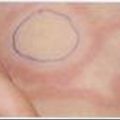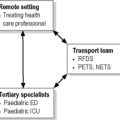7.2 Gastrointestinal bleeding
Introduction
The epidemiology of GI bleeding in children is very limited. The reported incidence of GI bleeding of 6.4% in paediatric ICU patients1 and the most frequent diagnoses confirmed endoscopically2 (duodenal and gastric ulcers, oesophagitis, gastritis, and varices) represent selected populations and are not representative of the ambulatory paediatric population.
Aetiology
The aetiology of GI bleeding is best considered within defined age groups, with some overlap between groups, and the likely location of the bleed, as guided by history and examination (see Tables 7.2.1 and 7.2.2).
| Neonates | Infants | Toddlers and school age |
|---|---|---|
| Ingested maternal blood | Anal fissure | Anal fissure |
| Necrotising enterocolitis | Protein sensitive enterocolitis | Juvenile colonic polyps |
| Protein-sensitive enterocolitis | Hirschsprung’s enterocolitis | Infectious gastroenteritis |
| Hirschsprung’s enterocolitis | Ischaemic enterocolitis | Meckel’s diverticulum |
| Ischaemic enterocolitis | Infectious gastroenteritis | Intussusception |
| Infectious gastroenteritis | Meckel’s diverticulum | Ischaemic enterocolitis |
| Congenital bleeding disorders | Intussusception | Haemolytic uraemic syndrome |
| Haemolytic–uraemic syndrome | Henoch–Schönlein purpura | |
| Bleeding disorders | Inflammatory bowel disease | |
| Vascular malformation | Vascular malformation | |
| Inflammatory bowel disease | Bleeding disorders |
History
Details of the timing of the blood appearing in the vomitus or bowel motions, in relation to other events, may give a clue to alternative sources of the blood. For example, the ingestion of substances such as iron or food colourings, onset of epistaxis or recent oral or ENT surgery, indicate a source of bleeding other than from the GI tract (Table 7.2.3).
History of ingestion of food colouring or iron supplements
Ingestion of maternal blood at delivery or breast feeding
History of epistaxis, post ENT or oral surgery or pharyngitis
Lower GI tract – haematochezia, redcurrant jelly stools
Resuscitate immediately if haemodynamic compromise
Bilious vomiting – volvulus
History of chronic liver disease – oesphageal varices
Renal or haemotological abnormalities
Investigations
Imaging
Nuclear medicine studies such as technetium pertechnetate scan for ectopic gastric mucosa in a Meckel’s diverticulum may have a role in investigating the cause of GI bleeding. However, the Meckel scan has a relatively low negative predictive value and may not obviate the need for operative evaluation despite a negative scan, where clinical suspicion is high.3 Other imaging techniques such as ultrasound and contrast air enema for intussusception should be considered in children under the age of 2 years with abdominal pain, GI bleeding and lethargy.
Treatment
Pharmacological treatment
Studies addressing the use of H2 antagonists and proton pump inhibitors (PPIs) for acute upper GI bleeding are restricted to the adult population. PPIs have been shown in systematic reviews to reduce the risk of further bleeding and need for surgery for peptic ulcers.4 However, the routine use of H2 antagonists or PPIs in children with acute GI bleeding cannot be recommended as bleeding gastric ulcers are very uncommon.
Infants with a presumptive diagnosis of cow’s milk protein intolerance should be changed to a hydrolysed protein formula with expected improvement within days. Mothers of breastfed infants can be advised to eliminate all dairy products from their diet if this diagnosis is considered for their infant.5
Surgery
Laparoscopy or laparotomy for investigation of lower GI bleeding may be both a diagnostic and therapeutic tool in children with GI bleeding of obscure origin. A study of 17 children with GI bleeding and no identifiable source after upper endoscopy and colonoscopy found that eight patients had Meckel’s diverticulum at laparoscopy, five patients had other GI pathology that accounted for symptoms and four patients had normal findings.6 Laparotomy may be necessary for acute abdominal emergencies such as intussusception unsuccessfully reduced at air enema, midgut volvulus or for management of continuous or recurrent active GI bleeding with haemodynamic compromise.
Endoscopic sclerotherapy
Injection sclerotherapy for oesophageal varices in children is well established with a reported efficacy of controlling active bleeding and eradication of varices exceeding 90%.7 Complications can occur, including oesophageal ulceration leading to stricture formation. Variceal band ligation may be limited by size in infants and small children.
Dispositon
1 Lacroix J., Nadeau D., Laberge S., et al. Frequency of upper gastrointestinal bleeding in a paediatric intensive care unit. Crit Care Med. 1992;20:35-42.
2 Cox K., Ament M.E. Upper gastrointestinal bleeding in children and adolescents. Paediatrics. 1979;63:408-413.
3 Swaniker F., Soldes O., Hirschl R.B. The utility of technetium-99m pertechnetate scintigraphy in the evaluation of patients with Meckel’s diverticulum. J Pediatr Surg. 1999;34:760-764.
4 Leontiadadis G.I., Sreedharan A., Dorwrad S., et al. Systematic reviews of the clinical effectiveness and cost-effectiveness of proton pump inhibitors in acute upper gastrointestinal bleeding. Health Technol Assess. 2007;11:iii-iiv. 1–164
5 Maloney J., Nowak-Wegrzyn A. Educational clinical case series for pediatric allergy and immunology: Allergic proctocolitis, food protein-induced enterocolitis syndrome and allergic eosinophilic gastroenteritis with protein losing enteropathy as manifestations of non-IgE-mediated cow’s mild allergy. Pediatr Allergy Immunol. 2007;18:360-367.
6 Lee K.H., Yeung C.K., Tam Y.H., Ng W.T., Yip K.F. Laparoscopy for definitive diagnosis and treatment of gastrointestinal bleeding of obscure origin in children. J Pediatr Surg. 2000;35:1291-1293.
7 Fox V.L. Gastrointestinal bleeding in infancy and childhood. Gastroenterol Clin North Am. 2000;29:37-66.






